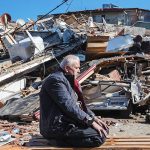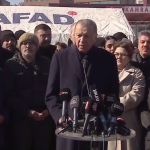Arti Gercek reports that thousands of people died and tens of thousands were injured as a result of the 7.7 magnitude earthquake that took place on February 6 in Maras’s Pazarcik district, hitting Kilis, Diyarbakir, Adana, Osmaniye, Antep, Urfa, Adiyaman, Malatya, and Hatay. While search and rescue efforts continue in the wreckage of hundreds of collapsed buildings, the danger of hypothermia has increased for earthquake survivors who are stranded in severe weather reaching sub-zero degrees.
One of the cities most affected by the Maras earthquake was Adiyaman. Speaking 30 hours after the earthquake, Adiyamanlilar Foundation Ankara Branch President Huseyin Duran had made the statement, “There are people still alive in these buildings. Right now, they cannot be rescued because there is not enough equipment. We have determined that some corpses froze to death.”
BODY TEMPERATURE SHOULD NOT FALL BELOW 35 DEGREES
Emphasizing that hypothermia is a medical situation requiring emergency intervention, Dr. Bengi Baser, PhD, and Dr. Osman Kucukosmanoglu, PhD, warned that hypothermia is caused when the body loses more heat than it can produce.
Noting that the danger begins when the body is exposed to cold without protection, the physicians drew attention to the life-threatening danger of body temperature falling below 35 degrees, where it is normally 36.5 to 37 degrees.
UNTIL MEDICAL AID ARRIVES, KEEP PEOPLE WARM
Stating that symptoms such as shivering, fatigue, feeling faint, confusion, slurring speech, and drowsiness can be observed in people with hypothermia, the experts say that it is vital that these people be covered by a blanket or moved to a warmer location and that any wet clothing items be removed.
Cardiovascular diseases specialist Dr. Baser noted that the risk of hypothermia begins if body temperature falls below 36 degrees, and that the likelihood of death increases if temperature drops to 35 degrees.
Stating that when individuals are exposed to cold, the body exerts all its energy on trying to maintain its heat, Dr. Baser commented, “This is the beginning of freezing. Bodily functions, especially those of the cardiovascular system and nervous system, cease to work and the person dies.”
WITHOUT INTERVENTION, PEOPLE WILL FREEZE TO DEATH
Stating that there is no other option but to warm up the body immediately, Dr, Baser emphasized that this is a race against time and drew attention to the risk of people freezing to death in case of late intervention.
Noting that people who had died of hypothermia were found in the earthquake-hit area, Dr. Baser said, “If there is no intervention, if things to warm the body, like blankets, are not provided, they will freeze to death. Food is also essential. Food and water must be provided.”
THERE ARE DELAYS IN INTERVENTION
Pointing out that intervention is of vital importance in the earthquake-hit area, especially on the first day, Kucukosmanoglu said, “After 24 hours, the situation is graver. Factors such as the person’s age, general health condition, and their situation under the rubble come to play. But the chance of a person surviving more than a few days under the rubble is very low.”
In Dr. Kucukosmanoglu’s opinion, a lack of organization and a delay in interventions is in question. Kucukosmanoglu, who believes that every second is critical in search and rescue efforts, time is lost in transportation, shelter, and heating, says field hospitals should have been established quickly.
“HUNDREDS OF VOLUNTEER DOCTORS ARE WAITING TO GO; WE ARE WAITING FOR THE GO-AHEAD FROM THE MINISTRY OF HEALTH”
Osman Kucukosmanoglu, who finds the structural damage to health institutions and the collapse of the state hospital in Maras and Hatay to be unacceptable, added that hundreds of volunteer doctors were waiting to be sent to the area, but that they were waiting for permission to proceed from the Ministry of Health.
Source: Gerçek News



